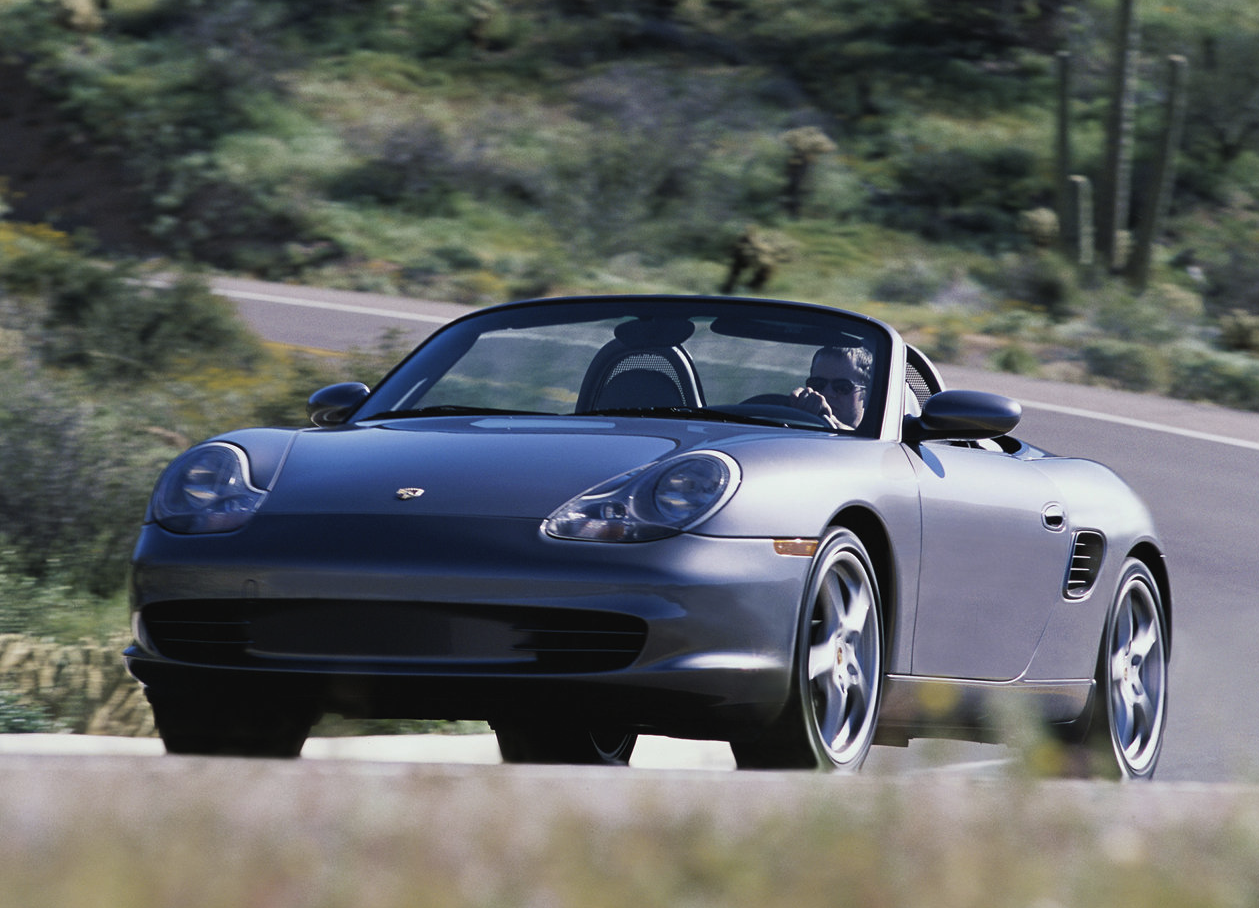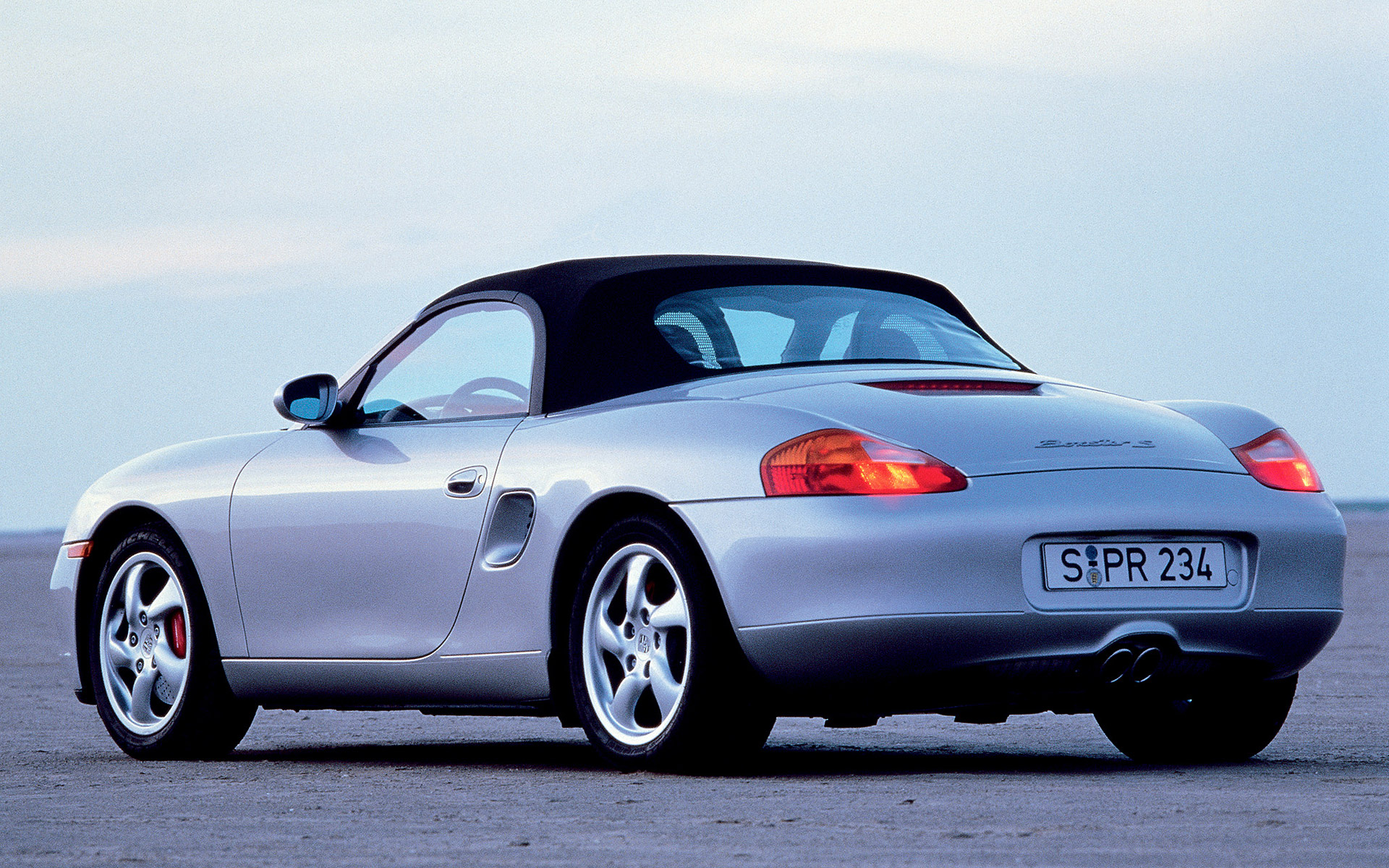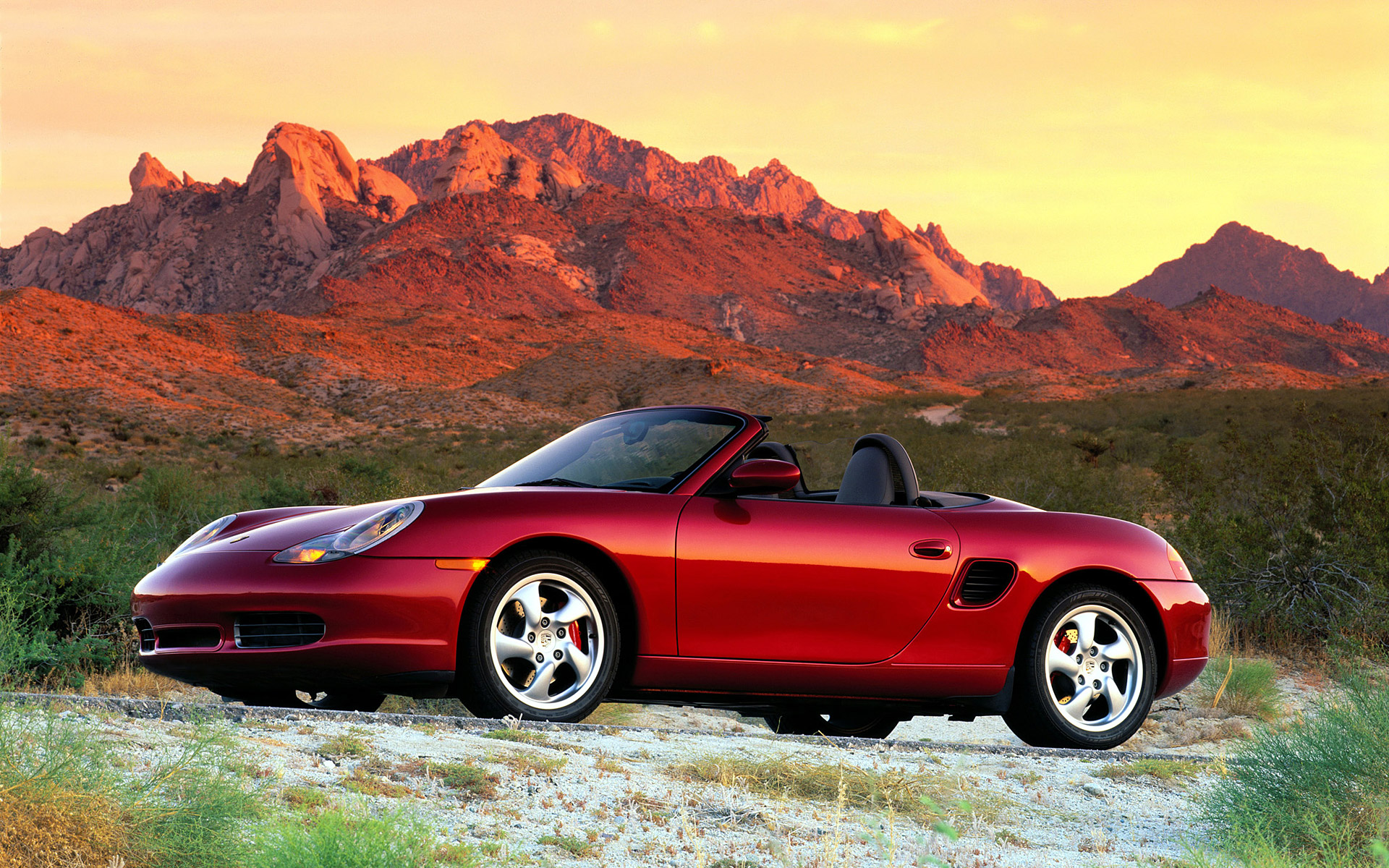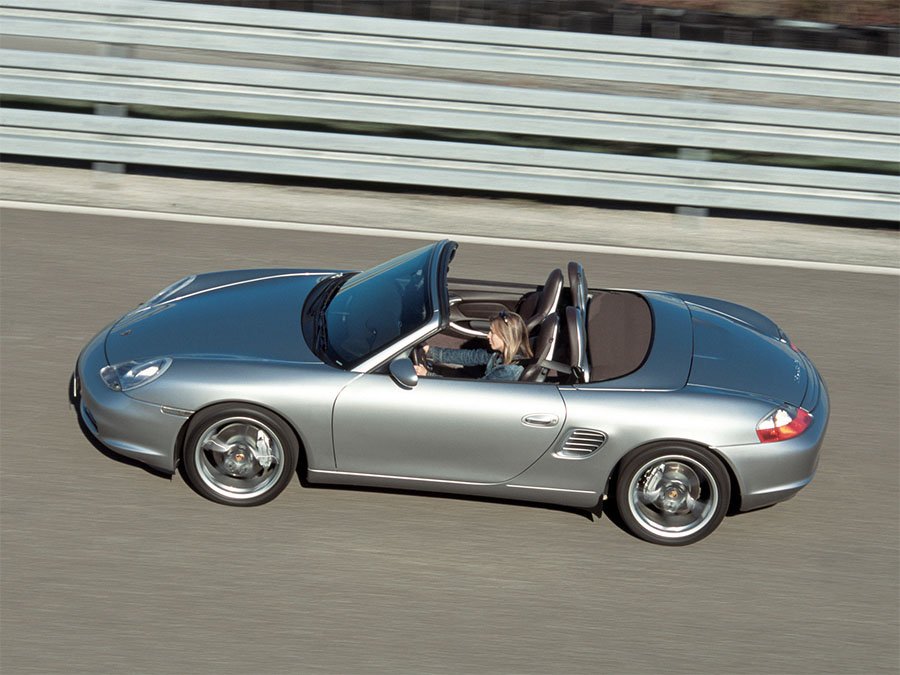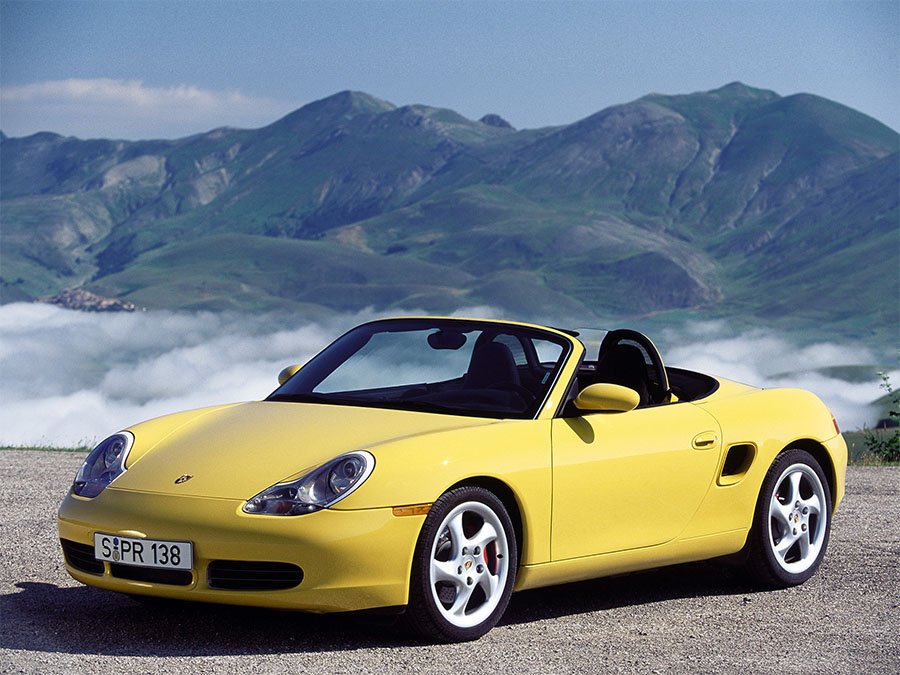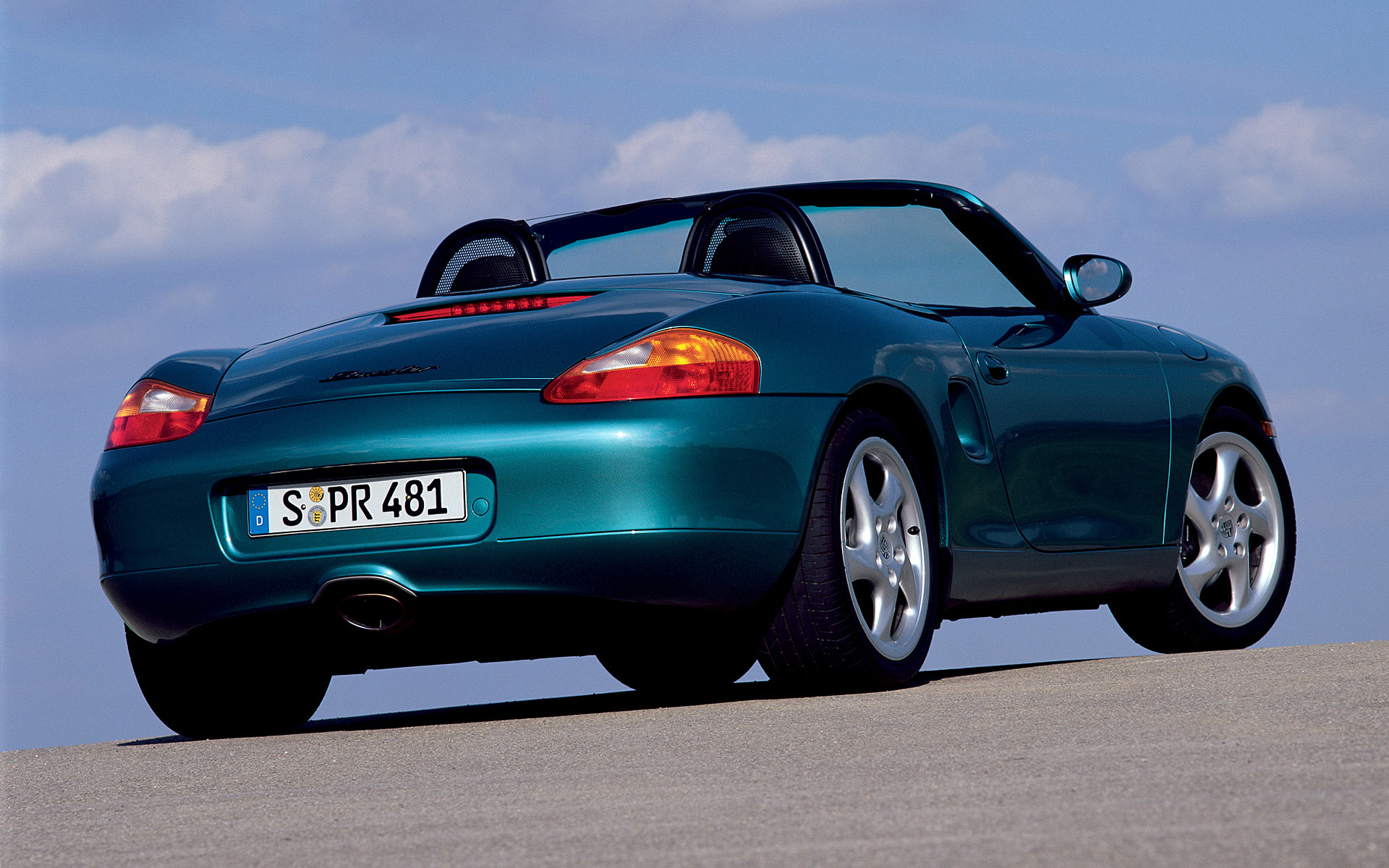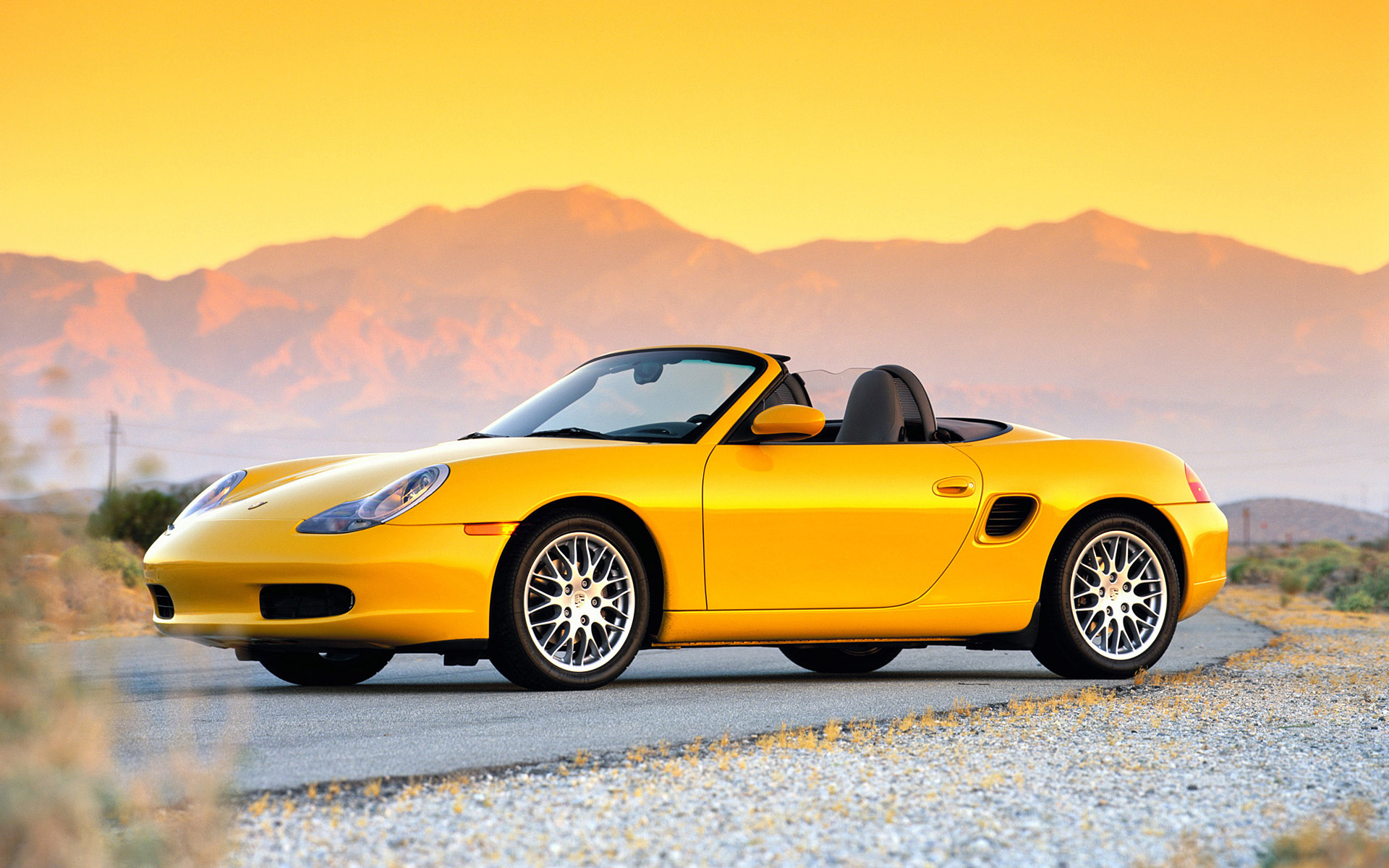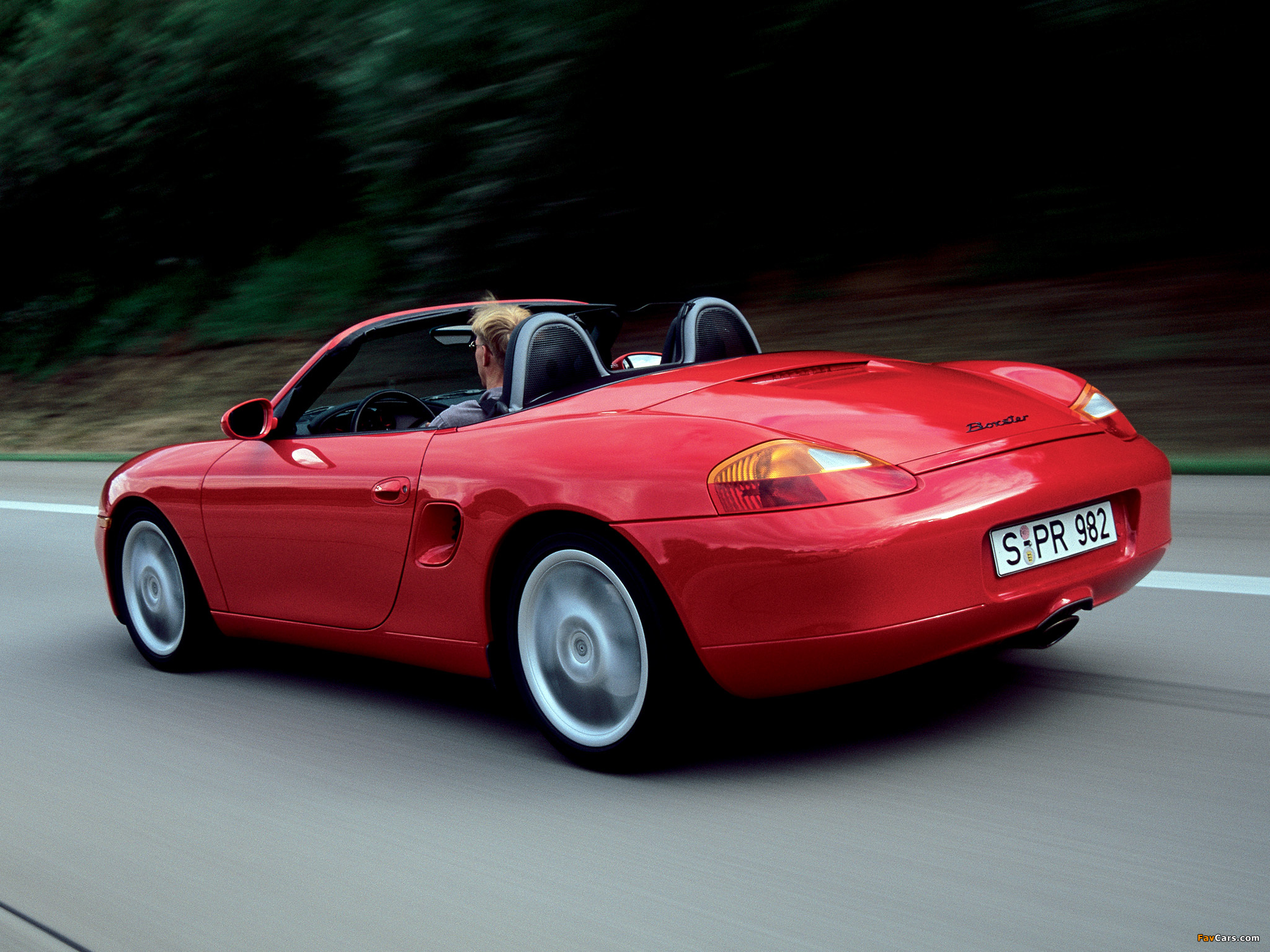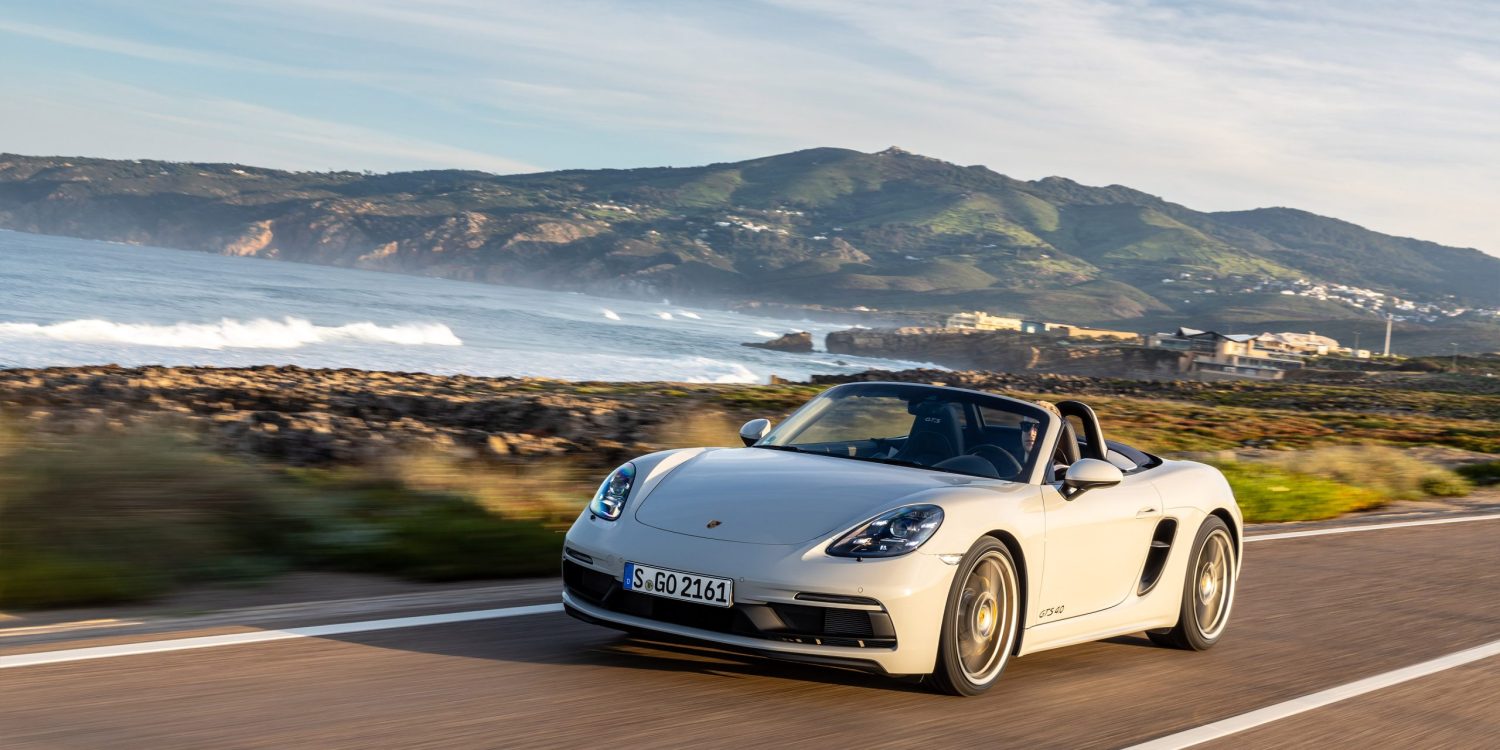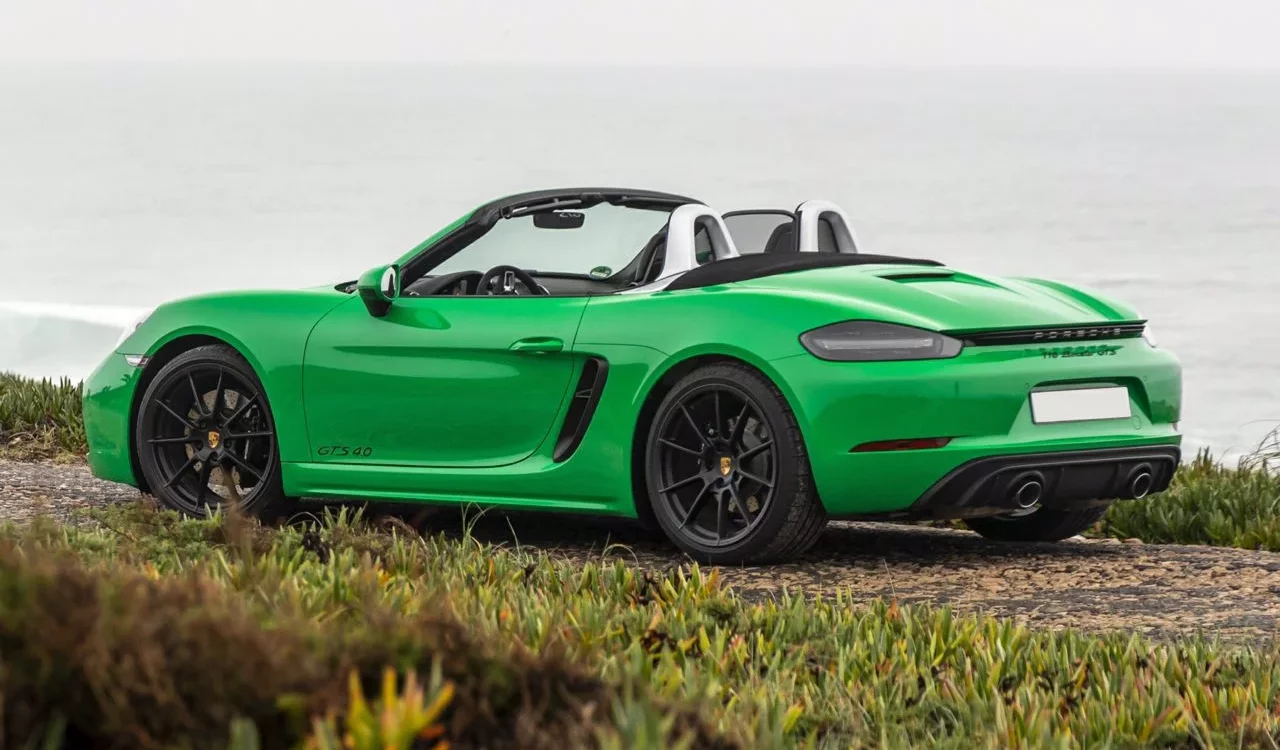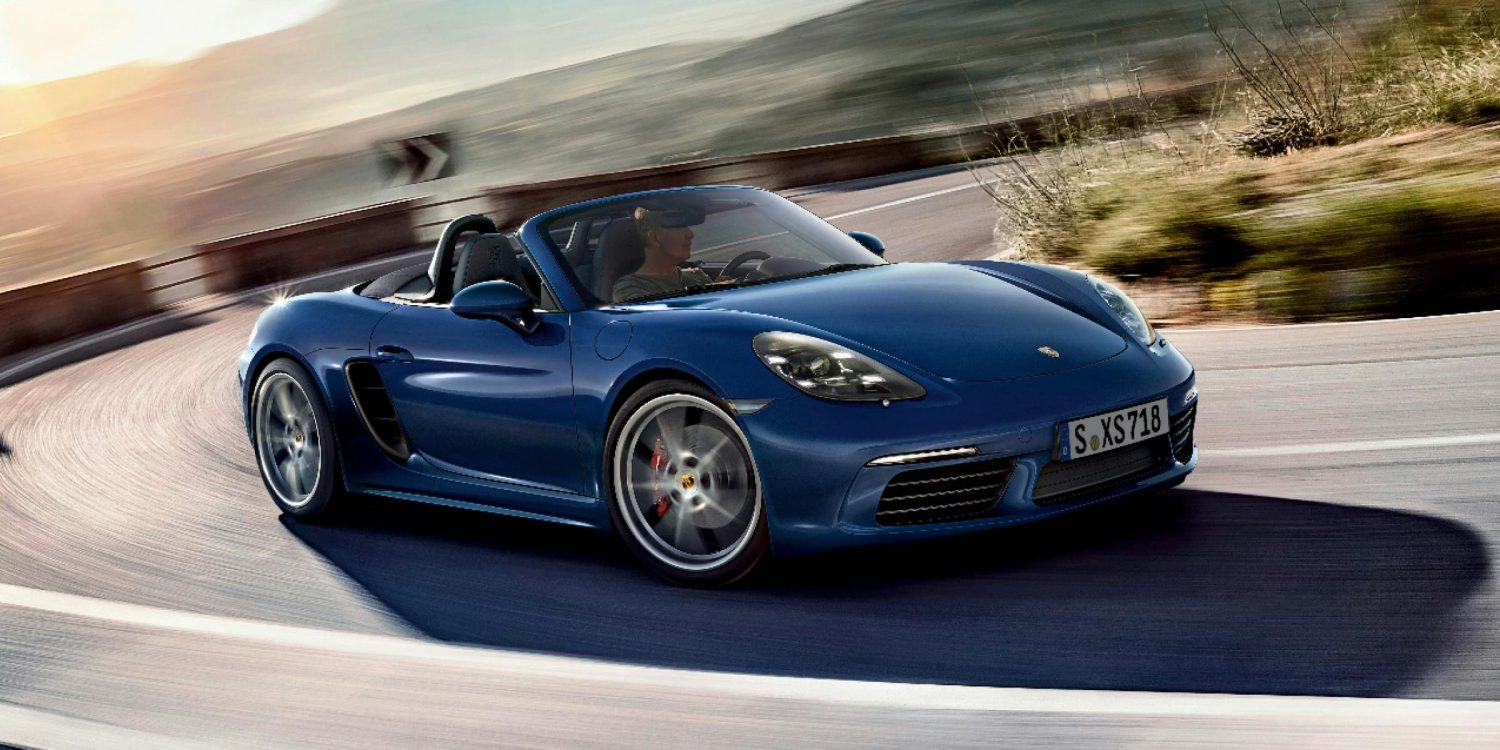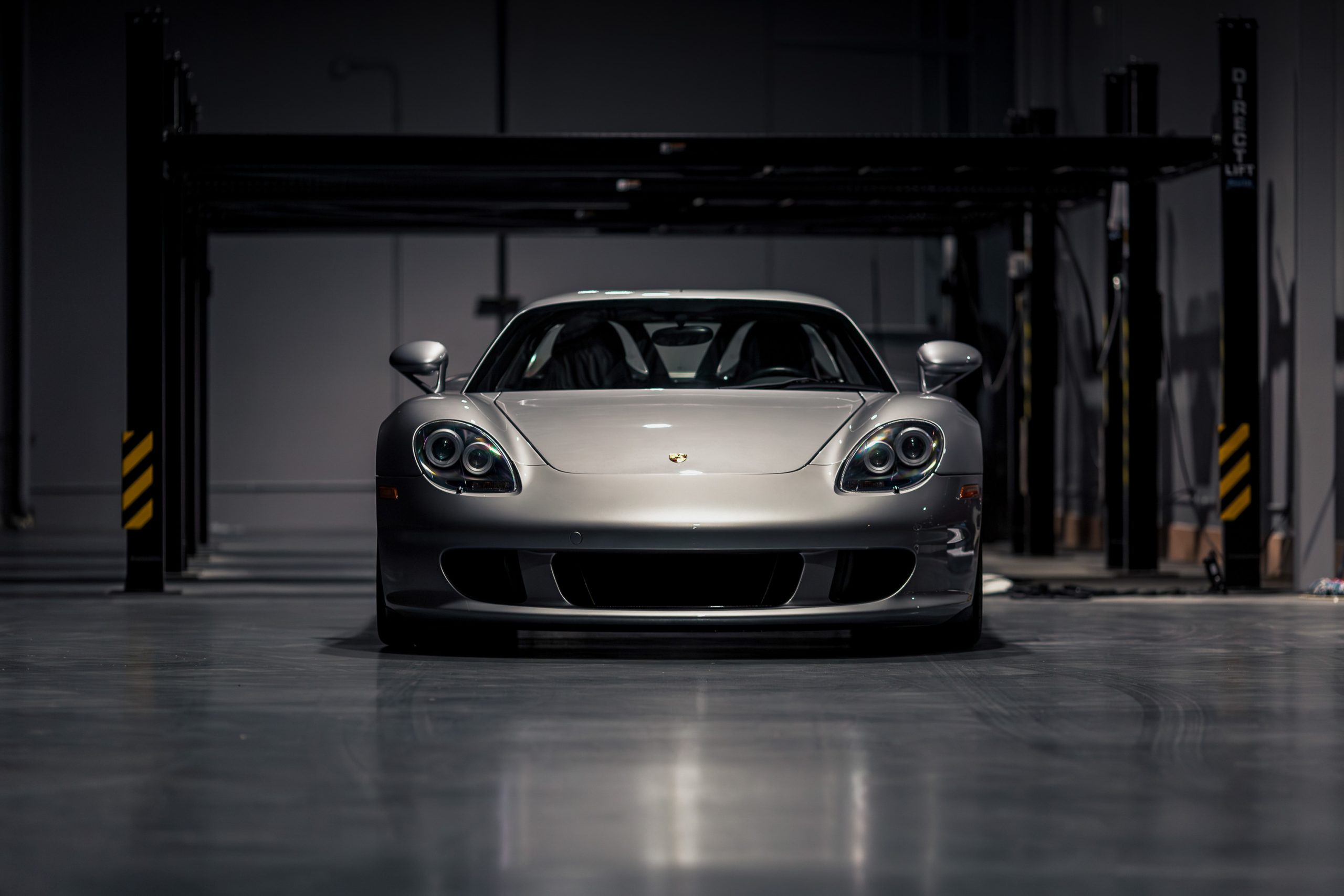1st Generation Porsche Boxster 986 Buyer's Guide
Buying a first generation Boxster? Our Guide Covers Key Models, Potential Issues, Values, Tips & More.
The Porsche Boxster 986, produced from 1997 to 2004, marked a pivotal moment for Porsche—reviving the brand’s fortunes with a mid-engine roadster that brought balance, performance, and driving joy to a broader audience. As the first water-cooled production Porsche sports car, the 986 laid the groundwork for the brand’s modern era while capturing the spirit of the iconic 550 Spyder. Lightweight, agile, and unmistakably Porsche in both sound and handling, the 986 Boxster has aged into a legitimate modern classic—and one of the most accessible ways to get behind the wheel of a true driver's car.
Today, the first-generation Boxster represents exceptional value on the used market, with clean, well-maintained examples offering thrilling dynamics for a fraction of the cost of newer models. But like any older sports car, the 986 comes with a few well-known pitfalls—IMS bearing issues, RMS leaks, and coolant tank failures, to name a few. The trick is knowing which years and versions to seek out and how to evaluate a potential purchase with confidence. The later 2003–2004 models, particularly the Boxster S with the 3.2L engine and updated styling, tend to be the most desirable, offering improved refinement, better performance, and fewer early-production teething issues.
In this Used Porsche Boxster 986 Buyer’s Guide, we’ll cover key variants, year-by-year changes, common problems, maintenance expectations, and market pricing trends. We’ll help you understand what makes the 986 special, what to look for in a good example, and why, with the right approach, the first-generation Boxster is one of the most rewarding and underrated sports cars Porsche has ever built. Whether you're hunting for a weekend toy or an affordable entry into Porsche ownership, the 986 still delivers the magic.
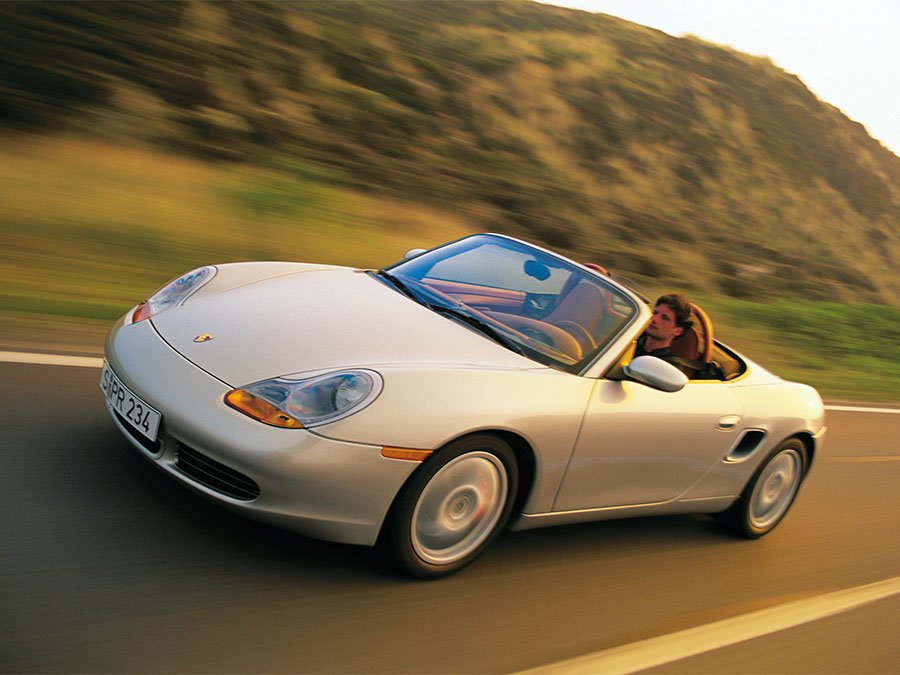
The innovative mid-engine Boxster was the first result of Porsche’s spectacular return to form at the end of the 1990s
An entry model was a well-established offering at Porsche which began in 1968 with the 4-cylinder 912 which in turn was supplanted by the 914. Unlike the 912 which was a considerable success, the 914 suffered something of an identity crisis and flopped in Europe; 95% of sales were in the US.
The long-running 924 which came next was initially controversial because of its substantial use again of VW Audi components, but over fifteen years, it provided solid turnover for Porsche and vital profits for dealers at times when 911 sales were thin and it also sired the much-admired 944, always referred to as “a real Porsche.”.
However, models age and by the mid 1980s Porsche was acutely aware of the need for a new entry-level model: its Styling department even mocked up a possible successor, the Type 984, a Mazda MX 5 (Miata)-size two-seater with a rear-mounted four-cylinder engine; the project was abandoned after three years’ intermittent study because it was clear it would never be profitable at the price Porsche wanted to pitch it.
As the decade ended, Porsche was in a poor state. The collapse of the dollar had drastically reduced US sales and the company found itself with a 911, the 964 with limited appeal beyond Porsche enthusiasts and an aging range of transaxle models.
At the top, heads would roll and new management at Zuffenhausen led by Wendelin Wiedeking brought much-needed fresh thinking. He had been highly critical of Porsche’s disparate model ranges and their lack of common parts. Now he galvanised two fundamental proposals to rescue Porsche from the financial doldrums: the company would abandon air cooled engines, the hallmark of Porsche since its beginnings, and even more radical, redesign the future 911 so that as much as possible would be interchangeable with a second, lower cost Porsche.
Platform sharing had no precedent in small-production car manufacturing, but the advantages were manifold. The most expensive part of the car to build is the front which represents a disproportionately large part of the manufacture cost as it includes all the crash protection structure, the car control systems, the electrical loom and instrumentation and air conditioning as well as the door frames.
The cost savings achieved by ‘doubling up’ here would be immense. It was exactly the kind of drastic measure Porsche would have to undertake to survive. It was to prove a brilliant idea of which the first public inkling was at the 1993 Detroit motor show: Porsche stylists exhibited a striking, mid-engine Concept two-seater. This created a sensation among journalists who had flocked to Porsche’s stand in a gloomy corner of the exhibition hall, many anticipating that on the basis of the company’s long run of poor sales, this show might even be Porsche’s last in America.
Instead, they were stunned by Porsche’s smooth new Concept. Acclaim, not just in Porsche’s largest market, was immediate and it inspired the company’s engineers and stylists that they were on the right path. The Concept also held clues to future 911 direction as well as marking the genesis of the Boxster.
1st Gen Boxster 986 Variants - A Quick Primer for Potential Buyers On The Variants & Specials To Think About.
We already have ultimate guide to the Porsche Boxster 986 so we don't want to repeat everything here. Instead, we will give you a quick primer and summary about the main first generation Boxster variants, some of the core model year changes and we will talk about some special editions worth noting as you think about your potential purchase.
Key Variants & Differences
1997-1999 Boxster 2.5 (aka 986 2.5)
Engine & Power: 2.5L flat six / 201 hp / 181 lbs-ft
Curb Weight: 2,822 lbs (manual), 2,954 lbs (tiptronic)
0 to 60 MPH: 6.7 seconds (manual), 7.4 seconds (tiptronic)
Original MSRP: $39,980
The original Boxster launched in 1997 with a 2.5-liter flat-six engine producing 201 hp and 181 lb-ft of torque. This was the purest version of the car—lightweight, nimble, and a return to Porsche’s mid-engine roots. These early models are also the most prone to mechanical issues, including IMS bearing failure, porous engine blocks, and cracked cylinder liners. Perfect for enthusiasts looking for the raw, minimalist Boxster experience on a budget.
2000-2002 Boxster 2.7 (aka 986 2.7 Mk I)
Engine & Power: 3.2L flat six / 217 hp / 192 lbs-ft
Curb Weight: 2,778 lbs (manual), 2,888 lbs (tiptronic S)
0 to 60 MPH: 6.4 seconds (manual), 7.2 seconds (tiptronic S)
Original MSRP: $41,430
In 2000, Porsche updated the base Boxster with a new 2.7-liter engine, boosting power to 217 hp and 192 lb-ft, improving drivability and reducing 0–60 times. The 5-speed manual remained standard, with the Tiptronic S also offered. These models retained much of the lightweight feel but with fewer of the engine vulnerabilities seen in the 2.5L cars. Great for drivers wanting a better-sorted, more powerful alternative to the early 2.5, without stepping up to the cost of a Boxster S.
2000-2002 Boxster S 3.2 (aka 986 S Mk I)
Engine: 3.2L flat six / 250 hp / 225 lbs-ft
Curb Weight: 2,855 lbs (manual), 2,943 lbs (tiptronic S)
0 to 60 MPH: 5.7 seconds (manual), 6.3 seconds (tiptronic S)
Original MSRP: $50,695
Also debuting in 2000, the Boxster S brought real performance credentials to the range. With a 3.2-liter flat-six producing 250 hp and 225 lb-ft, a 6-speed manual, larger brakes (shared with the 996 Carrera), and dual center-mounted exhaust tips, it was much more than just a bigger-engine Boxster. It featured standard 17-inch wheels, upgraded suspension, and enhanced interior trim, with leather and aluminum accents becoming more common. Great for enthusiasts who want the best early performance, mechanical simplicity, and driving experience.
2003-2004 Boxster 2.7 (aka 986 2.7 Mk II)
Engine: 2.7L flat six / 228 hp / 192 lbs-ft
Curb Weight: 2,778 lbs (manual), 2,888 lbs (tiptronic S)
0 to 60 MPH: 6.2 seconds (manual), 7.1 seconds (tiptronic S)
Original MSRP: $42,600
The facelift in 2003 brought updated clear-lens headlights and taillights, a glass rear window with defroster, interior material improvements, and more standard equipment. The 2.7-liter engine got a slight bump to 228 hp, and build quality improved noticeably. These models feel more refined and less spartan than earlier Boxsters.
2003-2004 Boxster S 3.2 (aka 986 S Mk II)
Engine: 3.2L flat six / 258 hp / 229 lbs-ft
Curb Weight: 2,911 lbs (manual), 3,000 lbs (tiptronic S)
0 to 60 MPH: 5.7 seconds (manual), 6.4 seconds (tiptronic S)
Original MSRP: $51,600
The facelifted Boxster S retained its 3.2L engine but gained a small power bump to 258 hp, improved interior fit and finish, and the same exterior upgrades as the base model. These later S cars feel significantly more mature and complete, with better insulation, more polished ride quality, and more modern conveniences. Among the most desirable 986 models.
2004 Boxster S Special Edition
Engine: 3.2L flat six / 258 hp / 229 lbs-ft
Curb Weight: 3,131 lbs (manual), 3,219 lbs (tiptronic S)
0 to 60 MPH: 5.7 seconds (manual), 6.4 seconds (tiptronic S)
Original MSRP: Approximately $57,000
Built to commemorate the 50th anniversary of the legendary 550 Spyder, this rare model was limited to just 1,953 units worldwide. Based on the facelifted Boxster S.
Model Year Changes (1997-2004)
The first-generation Porsche Boxster (986), produced from 1997 to 2004, saw a steady stream of improvements and refinements throughout its lifecycle.
While the core formula—a mid-engine, flat-six-powered, rear-wheel-drive roadster—remained unchanged, Porsche made key upgrades to engines, styling, interior materials, and reliability over the years.
Understanding the model year changes is crucial for any prospective buyer looking to get the best blend of performance, value, and long-term ownership confidence.
1997–1999: The Original Launch Years
The Boxster debuted in 1997 with a 2.5-liter flat-six engine, producing 201 horsepower. It was paired with either a 5-speed manual or 5-speed Tiptronic automatic transmission, and the car’s layout quickly earned praise for its balance and handling precision.
Early models were praised for their chassis but criticized for underwhelming power and basic interior trim.
These early 2.5L models are the lightest of the 986 generation but are also more prone to intermediate shaft (IMS) bearing issues, porous engine blocks, and interior wear due to lower-grade materials.
2000–2002: Introduction of the Boxster S & Engine Upgrades
The year 2000 brought a major refresh, with the launch of the Boxster S—featuring a 3.2-liter flat-six with 250 hp, a 6-speed manual transmission, larger brakes (from the 996), and dual exhaust.
The base Boxster also got an upgrade: its engine grew from 2.5 to 2.7 liters, now producing 217 hp, which greatly improved drivability. Interior updates were subtle, but build quality began improving, and performance across both models took a noticeable step forward.
These middle-year models are often seen as a sweet spot for value vs. performance—not yet carrying the price premium of the later years but avoiding the weakest early production flaws.
2003–2004: Mid-Cycle Refresh & Most Desirable Years
The 2003 model year brought the most significant visual and mechanical updates to the 986 Boxster.
Styling changes included new clear-lens headlights and taillights, updated front bumpers, glass rear windows with defrosters (replacing the old plastic ones), and subtle interior refinements.
More importantly, both models received power bumps: the base Boxster rose to 225 hp, while the Boxster S gained 8 hp (up to 258 hp).
Porsche also introduced glove boxes, better sound insulation, revised convertible top mechanisms, and improved materials throughout the cabin.
These 2003–2004 cars are generally considered the best and most reliable of the 986 series, having benefitted from years of refinement while still retaining the original, more analog driving feel.
They also tend to command a slight premium on the used market, especially low-mileage Boxster S examples with desirable options like PASM, Sport Package, or 18-inch wheels.
Final Thought
Each phase of the 986’s production has its appeal—early cars are light and pure but require caution; mid-range years balance cost and performance; and late 986s are the most complete and refined.
For buyers, 2003–2004 Boxster S models stand out as the best all-around choice, but even earlier cars can be excellent if they’ve been well-maintained and upgraded thoughtfully.
Understanding these year-to-year changes is the key to getting the right 986 for your budget and driving goals.
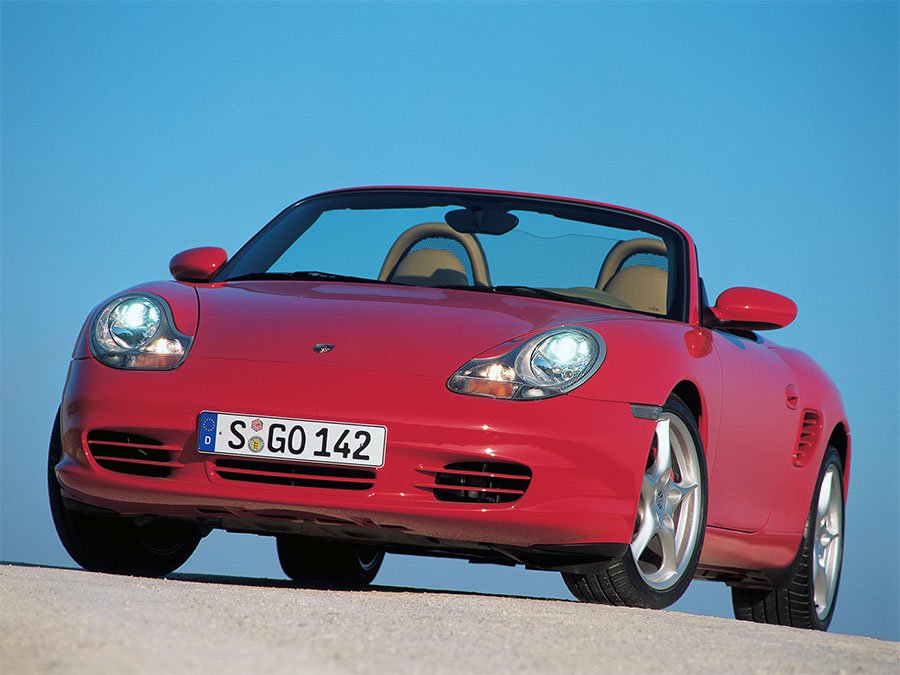
First Generation Porsche Boxster Market Value & Pricing
The first-generation Porsche Boxster (986) has become one of the most affordable ways to experience a true Porsche sports car, with market values reflecting both its accessibility and its growing recognition as a modern classic. Entry-level early models—particularly 1997–1999 2.5L cars—can be found for as little as $7,000–$12,000, though many of these are high-mileage examples that may need deferred maintenance or IMS bearing upgrades. Well-kept 2000–2002 Boxster 2.7s typically trade in the $12,000–$18,000 range, while the more powerful and desirable Boxster S models (especially 2003–2004) usually command $18,000–$28,000, depending on condition, mileage, and options.
At the top of the market, low-mileage 2004 Boxster S Special Editions (550 Spyder Editions) can bring $30,000–$40,000+, especially if unmodified and in collector-grade condition. Values across the 986 range are holding steady—and in some cases appreciating slightly—as enthusiasts come to appreciate the Boxster’s analog charm, mid-engine layout, and Porsche driving dynamics. The key to smart buying in this market is prioritizing condition, service history, and known problem resolution over year or mileage alone. With the right car, a 986 Boxster represents tremendous value for the money.
Factors That Affect Value
The value of a Porsche 986 (first-generation Boxster) is influenced by a mix of mechanical condition, model year, specification, and provenance. While the 986 is still one of the most affordable ways into Porsche ownership, certain examples are already appreciating—particularly low-mileage, late-model Boxster S variants and special editions. Here are the key factors that affect the value of a 986 Boxster:
1. Model Year & Variant
Not all 986s are created equal. Early 1997–1999 2.5L models are the least valuable due to lower power, more basic interiors, and a higher risk of mechanical issues. The 2000–2002 2.7L Boxsters are a step up in reliability and refinement, while the Boxster S models (2000–2004)—especially the facelifted 2003–2004 versions with the 3.2L engine—command higher values due to stronger performance and better features. The rare 2004 550 Spyder Edition (986 SE) is by far the most collectible and valuable 986.
2. Mechanical Condition & Service History
Because early Boxsters are now two decades old, mechanical condition is everything. Buyers and enthusiasts place a premium on cars with complete service records, documented maintenance, and key preventative work—particularly around IMS bearing replacements, RMS (rear main seal) leaks, and coolant tank failures. A well-maintained high-mileage car can be worth more than a low-mileage one with poor history.
3. Originality vs. Modifications
Original, unmodified examples—especially with factory options like Sport Package, 18-inch wheels, PASM, or upgraded leather interiors—tend to be worth more than heavily modified cars. While tasteful upgrades (like modern stereos or improved lighting) can add usability, things like aftermarket wheels, exhausts, or body kits can lower appeal for purists and collectors.
4. Mileage
Mileage affects value, but not as dramatically as condition and history. A low-mileage, garage-kept 986 with full records will always command a premium. That said, because these cars are relatively robust, a 70K–100K mile Boxster that’s been properly maintained can still be an excellent buy and hold value well—especially if major service items have already been addressed.
5. Color & Spec
Desirable exterior colors like Arctic Silver, Speed Yellow, Guards Red, or rarer paint-to-sample options can bump value slightly, especially when paired with full leather or two-tone interiors. Manual transmissions are almost universally more desirable than Tiptronic automatics, and certain factory options like heated seats, upgraded audio, or the Sport Design package can nudge values higher in today’s enthusiast-driven market.
Final Thoughts
The Porsche 986 Boxster is still undervalued in many ways, but buyers are becoming more discerning. Cars with good records, originality, desirable trims (like the 2003–2004 Boxster S), and limited production are already seeing stronger prices. As the 986 gains recognition as a modern classic, the best examples are likely to hold or appreciate in value—especially if kept stock, clean, and well cared for.
What You'll Pay
As of today’s market, the Porsche Boxster 986 (1997–2004) remains one of the most affordable entry points into Porsche ownership—but pricing varies significantly depending on model year, variant, condition, mileage, service history, and desirability. If you're shopping for one, you can find everything from project-grade early cars under $10,000 to collector-quality special editions well north of $30,000. The key is understanding what you're getting for the money—and what to expect in terms of ownership needs at each price tier.
At the lower end, early 1997–1999 Boxster 2.5 models often sell in the $7,000 to $12,000 range. These cars typically have higher mileage (80K–120K+), some cosmetic wear, and minimal recent service.
While they offer the most affordable way into the marque, they’re also the riskiest from a maintenance standpoint. Many still retain the original IMS bearing, and repairs like coolant tank replacement, RMS seal leaks, and suspension refreshes may be looming. If you're mechanically inclined or shopping on a tight budget, these cars can be great weekend projects—but they aren’t set-it-and-forget-it Porsches.
Stepping up to a well-maintained 2000–2002 Boxster 2.7—especially one with comprehensive service records, updated IMS, and cleaner cosmetics—you’re looking at $13,000 to $18,000. These cars offer a stronger driving experience than the early 2.5L models and improved reliability. Add a desirable color combo and factory options like heated seats or 17/18-inch wheels, and values tick up.
The best all-around value for many buyers, however, is found in the Boxster S (3.2L) models. A solid 2000–2002 Boxster S typically commands $16,000 to $22,000, while the updated 2003–2004 Boxster S (258 hp) with the facelifted styling, glass rear window, and upgraded interior is more in the $20,000 to $28,000 range. These later S models are widely regarded as the sweet spot of the 986 lineup and tend to hold their value better.
At the top of the market, you’ll find the 2004 Boxster S Special Edition (550 Spyder Edition)—a limited run of just 1,953 cars worldwide, featuring GT Silver paint, Cocoa leather, unique badging, and upgraded options.
These cars often have low mileage and collector interest, with values ranging from $30,000 to over $40,000 depending on condition and originality. They’re increasingly sought-after as the 986 era gains appreciation in the modern classic space. Similarly, pristine Boxster S examples with sub-40K miles, excellent provenance, and rare color combos (like Speed Yellow or Guards Red with full leather) can command a premium regardless of model year.
In short, the 986 market is full of opportunity—but also full of variability. The best buys today are often found in well-sorted 2003–2004 Boxster S models, which offer the most performance, refinement, and upside potential.
Regardless of budget, buyers should prioritize service records, IMS bearing updates, condition, and originality over low prices alone. With the right diligence, a first-gen Boxster can still be one of the most rewarding and accessible Porsche experiences available.
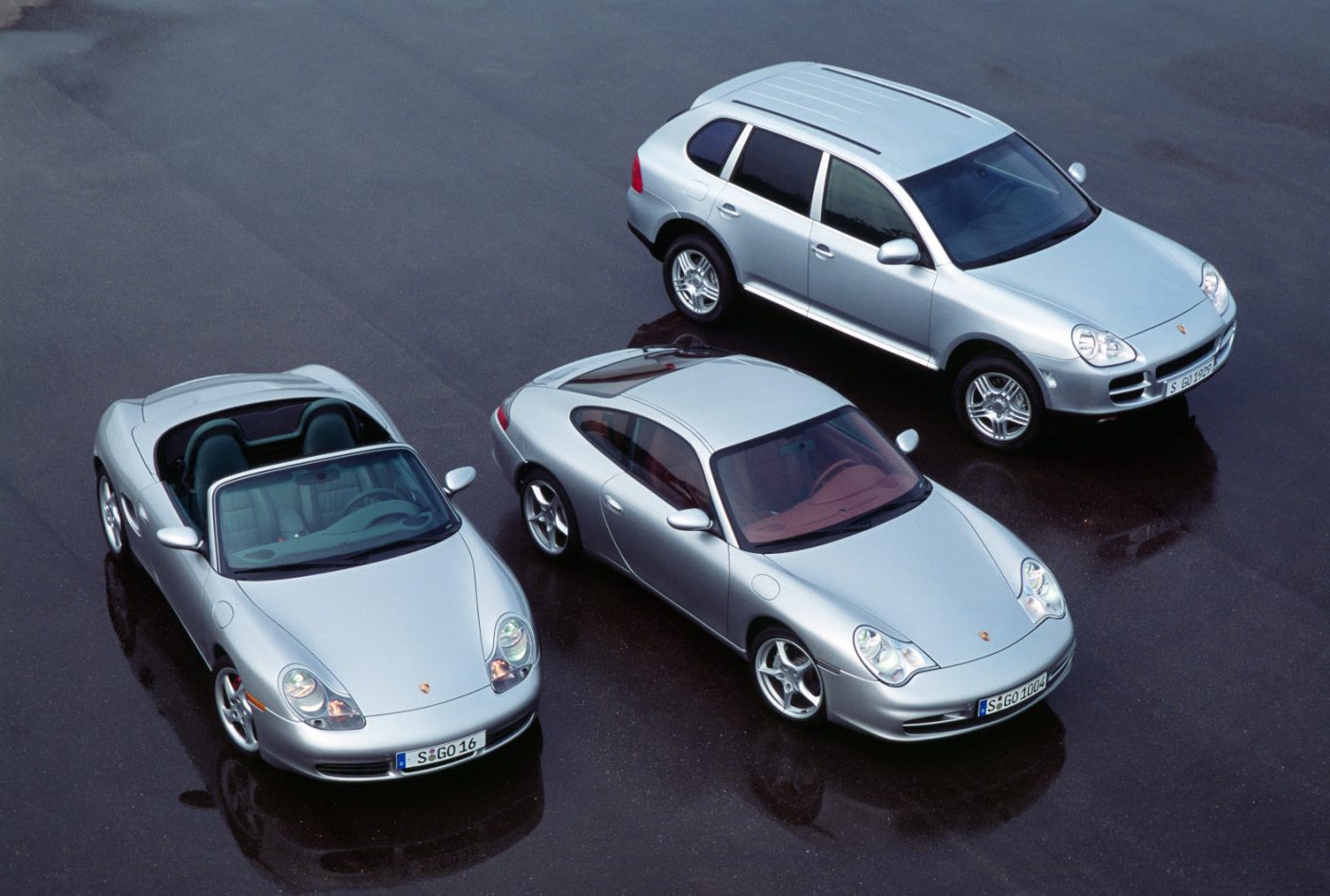
1st Gen Boxster - What to Look for In A Porsche 986 Boxster
Excluding $3000 offerings on eBay, often non-runners, the lowest prices are generally for the Boxster 2.5 and in the $8-$10,000 range. Well-known independent Northway Porsche reckons that 2.5 values have increased by perhaps $3000 since 2017.
This is beginning to save many cars from being scrapped (the fate of many Tiptronics in particular) as to put a car worth $3,000 right would be at least as much again and total costs would exceed market value. The 2.5 today is a reliable engine providing it has been correctly maintained, and even at the lower end of the market, a consistent service history is worth seeking out.
Ray Northway says the work he undertakes on the 2.5 these days is much the same as the preventive maintenance he would be carrying out on a twelve-year old 997, namely replacement of worn suspensions, dampers, bushes, control arms and attention to oil leaks and cooling systems. Corrosion does not cause the structural damage that afflicts the older air cooled 911s, but it does rot componentry on the cars’ undersides.
The same applies to the 2.7. Consistently maintained this engine is largely “bullet proof” says Northway technician Wes Thomas. He prefers the 2.7 to the 2.5 not only because it had more power and torque but also for its better-appointed interior. He has high regard for the 3.2 S:
Again, if the servicing has been done every year, it is a reliable engine. Over the years we have rarely seen intermediate shaft failure on any 986 Boxster; rear main seals we renew routinely with a clutch change otherwise sound cars will need only consumables and on Porsches this age that includes suspension parts, a/c components and sometimes engine work. The S has more torque and with 250-260 bhp, enough to have proper fun with.
He also makes the point that the aftermarket can supply many items for the 986 reducing cost of ownership and allowing some modest customization.
Engine
There are of course plenty of caveats when it comes 986 engines, but today they are almost all the result of neglected maintenance – misfires are often caused by deteriorating coil packs or failed Variocam solenoids; white smoke (as opposed to water vapour) on start-up is usually a sign the block is cracked (an expensive repair) and exhaust manifold bolts in particular rust famously making removal very labour-intensive.
Bodywork & Interior
986 paint dulls, but lasts well; the vulnerable front valance will often have been repainted at least once or even replaced; there should be no panel rust and if there is, accident repairs are usually the culprit and signal deeper investigation; the hood is an efficient design, but its motors may well be on their last legs; the material will show creases if it is left folded too long and develop holes.
Until MY2002, the hood had a plastic rather than glass window and its tendency to split is one reason to avoid the early 986. The cabin floor should be absolutely dry – water ingress will corrode it and cause electrical shorts in the control modules under the seats. The quality of materials used in the cabin improved steadily over the life of the 986. Switchgear on the earliest 986s can feel flimsy.
Options
Many early cars came with optional 17-inch five-spoke wheels and if these are worth looking out for, the lethargic Tiptronic is not, blunting the smaller capacity 986s in particular. Six speeds were a 2.7 option. Leather upholstery looks and wears better, but the heated seats if specified are unlikely still to be functioning.
If contemplating a higher priced example, check that the a/c (cold air) or full climate-control not only works, but that it has been rebuilt at some point: these systems do not last two decades without major overhaul.
Conclusion
Now a 20- or 25-year-old Porsche, if selected with care the 986 makes an attractive, low-cost sports car: in the 986 the potential buyer will find an essentially analogue model that, simpler and smaller (and more manoeuvrable) than the current Boxster has dated very little.
Purchasers need to decide whether they are acquiring the car to improve it or simply to use and enjoy. The latter means buying a more expensive 986 on which the major remedial work has been done, but for a car averaging say 5000 miles p/a, the owner should still plan for annual $1000 service costs and budget for twice that every third year.
The early Boxster is value-for-money fun with a capital ‘F’ and finding excuses to clock up those 5000 miles should not be difficult!
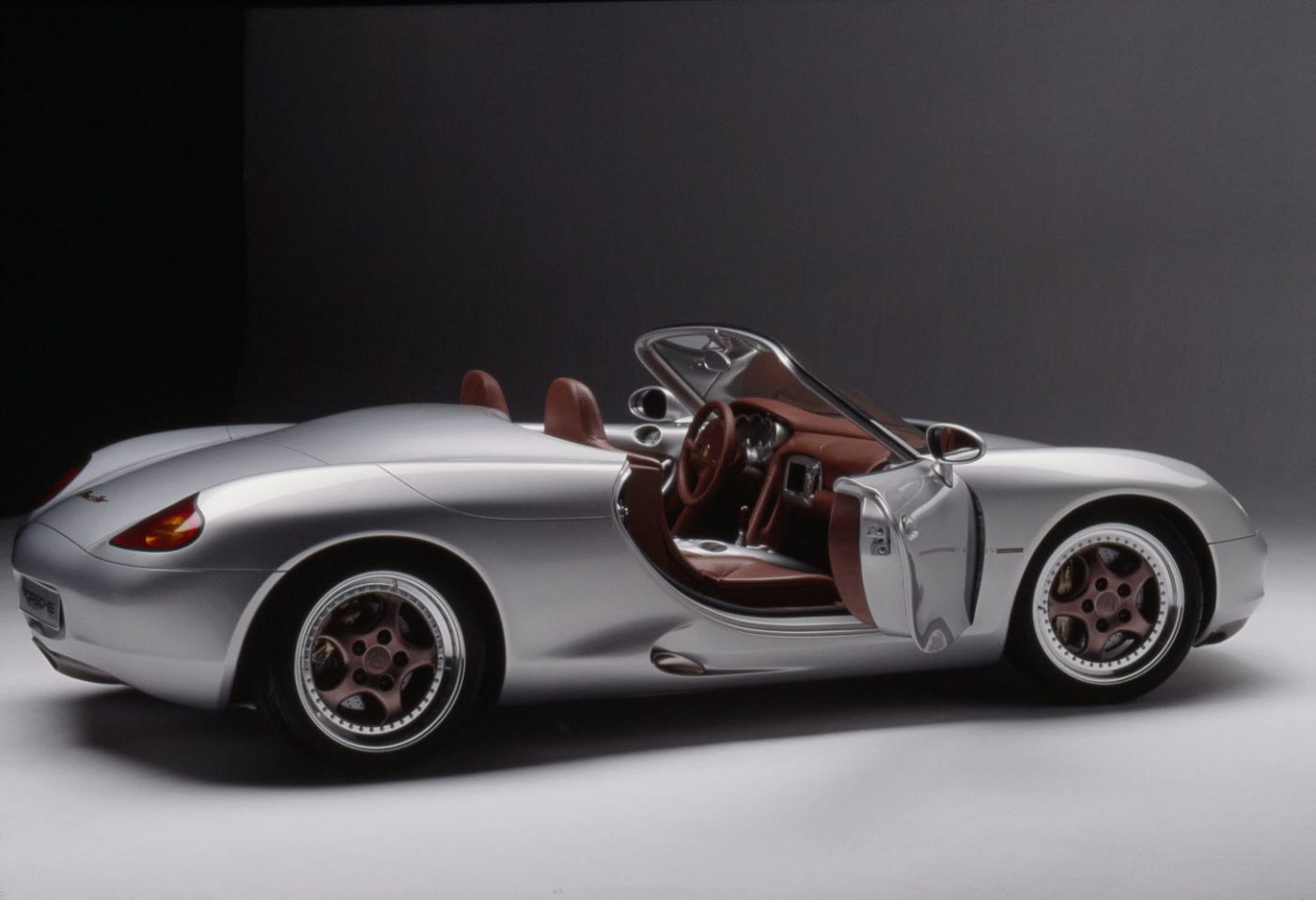
1st Gen Boxster - Development & Evolution
As it was almost a case of one template for two cars, at least their forward aspect, the styling models for the Boxster and the 996 were built alongside each other. This allowed the stylists to go as far as they could in differentiating their frontal aesthetics.
The Boxster was shod with its own 16inch wheels rather than the 17inch variety of the 911and its front valance would have different air intakes. The cabin, though obviously the 996’s had three instruments rather than the trademark five instrument display of the 911. The Boxster shared the 996’s doors. The same floor pan served both models though obviously engineered for the 300 horsepower 911.
The enduring legacy of this is that subsequent Boxsters and later the Caymans as well all developed the reputation of having chassis capable of deploying more power.
While front suspension and steering were very similar to the 996’s, cost and space meant it was impractical to mount the 911’s light, stable axle suspension at the rear. On the Boxster the engine was immediately behind the cabin with its gearbox at the rear like Porsche competition cars so its handling requirements were more neutral and conventional coil strut configuration featuring aluminium radius arms and a torsion anti-roll bar was employed.
The new flat six engine family was very different from its air-cooled forebear. Rather than six individual finned cylinders, the new bloc was cast in two modules of three cylinders cased in a water jacket; casting three cylinders at a time greatly reduced assembly time and costs, although initially the new design would not prove entirely reliable.
Like the original 1991cc 901 flat six of 1963, the engine was conceived for future expansion, but in its first iteration on the Boxster a bore/stroke of 85.5x72mm made 2490cc and with a compression ratio of 11.0:1 the output of 204bhp guaranteed a sufficient performance differential with the 296bhp planned for the larger capacity 996 which would enter the market priced over 40% higher.
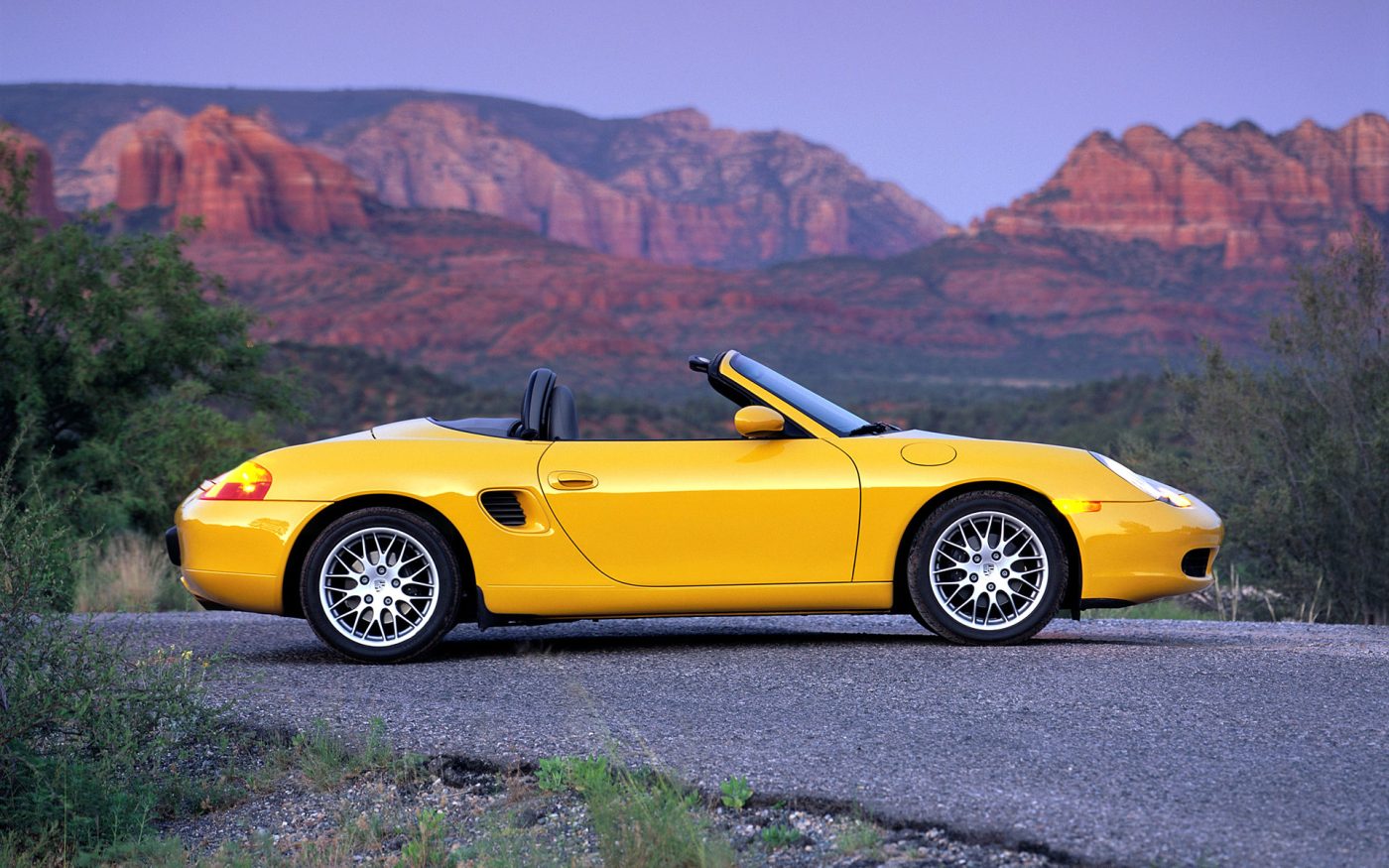
Although both 986 and 996 were ready at the same time, Porsche elected to launch the 986 first, in March 1996, seeking to test the water with its radical new mid-engine model and by extension prepare the market for the coming water-cooled 996. This decision was made easier as the 993 was selling well (1996 would prove its best year) which removed the pressure to rush the 996 to market. The Boxster was an immediate success, both with the motoring press and the market, so much so that in 1997 Porsche had to subcontract assembly to coachbuilder Valmet in Finland to meet demand.
In terms of performance, the 986, base retail price in US $39,900, was deemed to deliver value for money: all the road tests managed close to 140mph and 0-60 mph around 6.7 seconds and testers were unanimous in their praise for its sharp steering and good-natured handling and authoritative brakes.
The first significant changes for the 986 came in MY2001. Capacity was raised by taking 78mm stroke of the 3.4 996 to give 2687cc and 220bhp. Electronic ‘fly-by-wire’ throttle was introduced, its more precise control contributing marginal improvements in fuel consumption and allowing the 986 to benefit from the 996’s PSM stability management.
New surface treatment softened the shiny, rather plastic appearance of the dashboard, enhancing the cabin. Porsche also introduced the 986 ‘S.’ Distinguished visually by a third cooling intake grill and twin exhausts at the rear and in the cabin by its own white-background instruments, the S was in a higher performance category.
Unlike the 911 where ‘S’ at the time simply meant the widebody, the Boxster S had a much bigger engine, increasing the bore to 93mm to make 3179cc. With an additional 32bhp the improvement in acceleration was commensurate: 0-60mph now took 5.7 seconds and top speed was close to 160mph.
The real difference though was in torque: the S was noticeably more willing in the mid-range, though at around $49,930 it was also significantly more expensive. The advent of Variocam for MY2004, the final year of the 986 models again brought minor mpg improvements and boosted both torque and power, 228bhp for the base Boxster and 260bhp on the S.
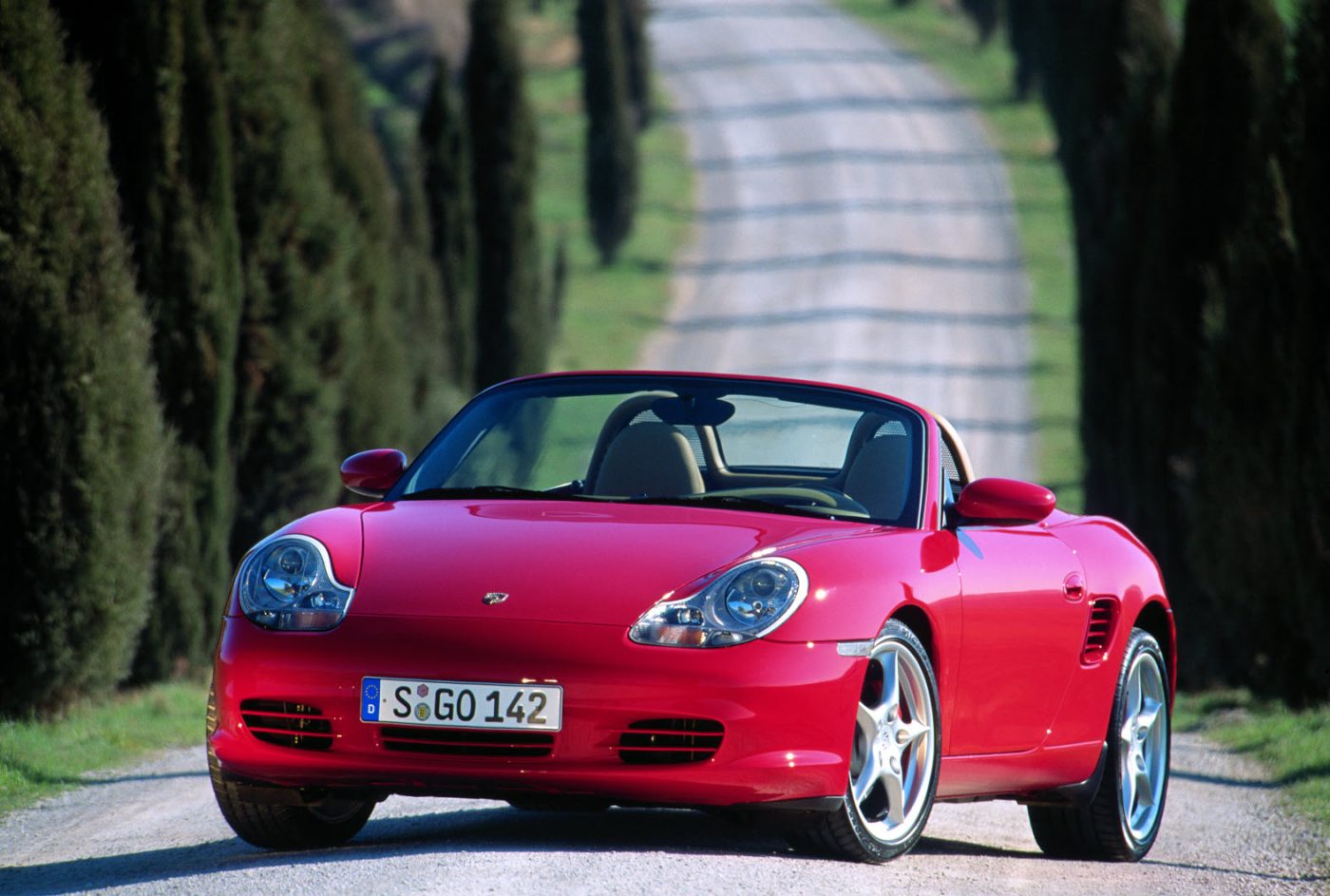
Getting Real - Costs to Own & Maintenance
Owning a Porsche 986 Boxster (1997–2004)—the first generation of Porsche’s mid-engine roadster—is one of the most affordable ways to get into Porsche ownership, but it’s still a high-performance German sports car, and that comes with specific maintenance expectations and long-term costs. Fortunately, the 986 is mechanically straightforward by modern standards, has strong aftermarket support, and benefits from decades of shared parts and knowledge within the Porsche community. If properly maintained, it can be a reliable and relatively inexpensive car to own—but neglected examples can quickly become money pits.
Maintenance Costs & What to Expect
Routine maintenance on a 986 Boxster is surprisingly reasonable. Oil changes, using high-quality synthetic oil, typically cost $100–$200, and should be done annually or every 5,000–7,500 miles. Other regular services—brake fluid flushes, air/oil separator checks, coolant reservoir inspections, and spark plugs—are all manageable and well-documented. You can expect to spend about $1,000 to $1,500 per year on maintenance if you’re driving the car regularly and staying ahead of preventive care.
Major service items include the clutch (if manual), which may need replacement around 60,000–80,000 miles, and costs around $1,200–$2,000 depending on labor rates and whether the flywheel also needs replacement. Cooling system parts (radiators, hoses, and water pump) are known wear areas, especially on older cars. And while timing chains don’t require routine replacement, tensioners and guides should be checked if the engine becomes noisy.
Parts Availability & Pricing
The 986 benefits from widespread parts availability, with OEM and aftermarket components readily accessible through suppliers like Pelican Parts, FCP Euro, and more. Since it shares many mechanical bits with the 996 911 and later Boxsters, there’s a healthy market of used and reproduction parts as well. For example:
Brake pads and rotors: $300–$600 per axle (OEM or upgraded)
Water pump kit: $250–$400
Convertible top repair kit: $150–$600 depending on scope
If you're mechanically inclined or have access to a good independent Porsche specialist, ownership costs can be kept low. Dealer servicing is typically more expensive but not always necessary—especially for older cars out of warranty.
Insurance Costs
Insurance on a 986 Boxster is generally modest, especially when compared to modern performance cars. For a driver with a clean record, expect to pay around $600 to $1,200 annually, depending on your location, age, and how many miles you plan to drive. Many owners insure their 986 as a second or collector car, often qualifying for specialty insurance or agreed-value policies through companies like Hagerty or Grundy, which can further reduce costs if it’s not a daily driver.
A well-maintained 986 Boxster offers a highly rewarding sports car experience with iconic Porsche handling and timeless styling—all at a fraction of the cost of newer models. While it's affordable to own compared to most Porsches, it does require regular attention and preventive maintenance. The key is to buy the right car—preferably with service history, a sorted IMS bearing (or plan to do it), and a clean ownership record. With those boxes checked, a 986 Boxster can be one of the best value classic sports cars on the market.
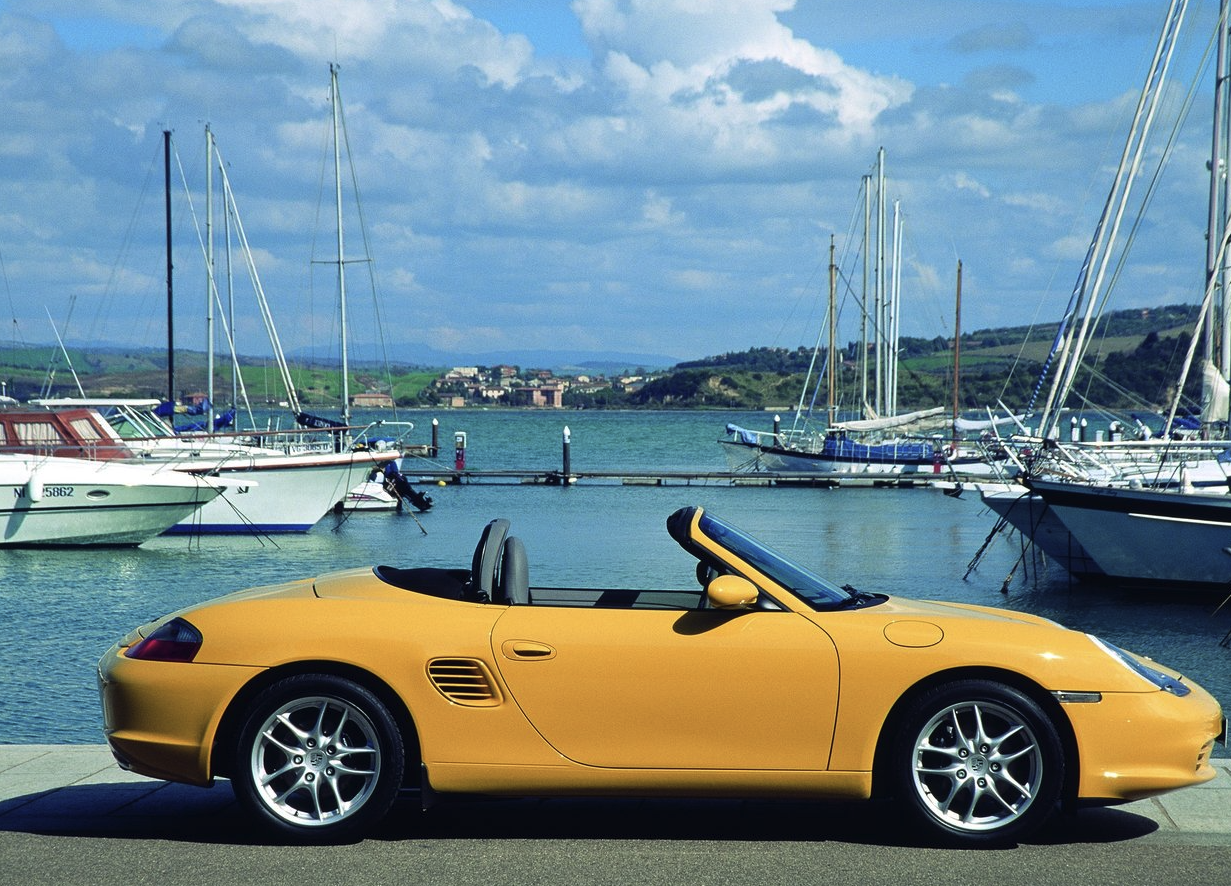
Common 1st Gen Porsche Boxster Problems
What Buyers Should Know
As rewarding and affordable as the first-generation Porsche Boxster (986, 1997–2004) can be, it’s not without its well-known flaws. These are engineering-intensive cars, and while they're generally durable when maintained, there are a number of common issues that potential buyers should be aware of. Understanding these problems ahead of time is critical—because buying the wrong 986 without doing your homework can quickly turn a $10K sports car into a $20K project.
1. IMS Bearing Failure (Intermediate Shaft Bearing)
This is the most infamous issue with 986 Boxsters, particularly 1999–2004 models with the M96 engine. The intermediate shaft bearing can fail catastrophically, causing complete engine failure. While the overall failure rate is relatively low (estimated at 5–8%), the risk is severe enough that many cautious owners preemptively replace the bearing with an upgraded unit (such as from LN Engineering). What to check: Look for documentation of an IMS retrofit. If it hasn’t been done, budget $2,000–$3,000 for the upgrade, often performed alongside a clutch replacement.
2. Rear Main Seal (RMS) Leaks
Oil leaks from the rear main seal are common on early Boxsters and were a known issue during this era of flat-six engines. While RMS leaks don’t always indicate imminent failure, they can lead to clutch contamination or worsen over time. What to check: During a pre-purchase inspection (PPI), look for oil residue at the bell housing. RMS replacement is labor-intensive, so it’s best tackled when doing a clutch or IMS bearing.
3. Air/Oil Separator (AOS) Failure
The air/oil separator regulates crankcase pressure and recirculates oil vapor, but when it fails, it can cause smoke from the exhaust, rough idle, or even hydrolock in extreme cases. It's a wear item that typically fails with age or mileage. What to check: If the car smokes at startup (especially bluish smoke), or has high oil consumption, the AOS may need replacement. The part itself is affordable (~$150), but labor can add another $400–$800.
4. Cooling System Failures
986 Boxsters are known for issues with their coolant reservoirs cracking, water pumps leaking, and radiators clogging with debris (especially the side-mounted units). Left unattended, these can lead to overheating—a serious risk for the M96 engine. What to check: Inspect coolant levels, look for any dried white residue in the engine bay (a sign of leaks), and listen for water pump noise. Radiator fans should cycle normally when hot.
5. Convertible Top Issues
Over time, the soft top cables, motors, and clamshell mechanisms can fail or fall out of alignment. Drainage tubes near the rear storage area can also clog, leading to water intrusion. What to check: Ensure the top operates smoothly and completely. Check for water stains or mold in the carpet behind the seats, which may indicate prior water ingress. A complete top motor or cable fix can cost $500–$1,500, depending on what's needed.
6. Cracked or Faded Interior Plastics
The 986 interior, particularly in early cars, can show wear quickly. Dash plastics, buttons, and trim may become sticky, scratched, or faded. While cosmetic, it can affect the ownership experience. What to check: Pay attention to climate control buttons, center console trim, and seat condition. Replacements are widely available but add up if you want to restore the cabin.
The 986 Boxster’s reputation for mechanical issues is often overblown—many of the problems are well-known, well-documented, and solvable. The key is finding a car with strong maintenance records, a recent PPI, and ideally, an upgraded IMS bearing and recent cooling system work. If you go in informed and selective, a first-gen Boxster can be one of the most fun-per-dollar cars on the road—and an iconic way to enter the world of Porsche ownership.
Buying A 1st Gen Porsche Boxster 986 FAQs
Here are all the questions we've received from readers considering a 1st Gen Boxster for their driveway
What are the top five things to look for when buying a 1st gen Boxster?
When buying a first-generation Porsche Boxster (986, 1997–2004), it’s important to go beyond surface-level condition and understand the specific mechanical and reliability factors that define a good example. These early Boxsters are some of the most accessible and enjoyable ways to experience Porsche ownership, but because they’re now 20+ years old, the quality of care they’ve received is far more important than mileage alone. Here are the five most important things to focus on when evaluating a used 986 Boxster.
First and foremost is the IMS bearing (intermediate shaft bearing). This is the most notorious issue associated with the 986, particularly from 1999 to 2004. A failed IMS bearing can lead to catastrophic engine failure, often without warning. Many responsible owners have already addressed this by upgrading to a more robust aftermarket bearing (such as the LN Engineering retrofit). If the IMS hasn’t been done, this should either be a strong negotiation point or a planned expense—typically around $2,000–$3,000, especially if paired with a clutch replacement.
Next is the cooling system, which is known to have several potential weak points on the 986. Components like the coolant expansion tank (located in the rear trunk), the water pump, and side-mounted radiators are all prone to aging, leaks, or clogging. Overheating is one of the fastest ways to shorten the life of the Boxster’s M96 engine, so it’s important to verify that the car reaches and maintains proper operating temperature and doesn’t show signs of coolant residue, overheating, or fan issues.
Another key area is the convertible top and its mechanisms. The Boxster’s power-operated soft top is fun and functional when working properly, but the motors, cables, and transmissions that drive it are known to wear out or fall out of alignment. Buyers should cycle the top fully and check for any hesitations, grinding sounds, or incomplete latching. It’s also crucial to check the carpets and rear seat area for water damage, as clogged drain tubes can cause leaks that lead to mold, mildew, or electrical issues.
The fourth consideration is the presence of any oil leaks, particularly from the rear main seal (RMS). While not as catastrophic as an IMS failure, a leaking RMS is common on these cars and can result in clutch contamination if left unchecked. If the RMS hasn’t been addressed and there’s oil seeping from the bell housing area, it’s worth factoring in a future repair—ideally timed with clutch service or an IMS upgrade. A good pre-purchase inspection (PPI) will confirm the extent of any active leaks.
Finally, and perhaps most importantly, is the car’s overall service history and documentation. A well-maintained Boxster with regular oil changes, documented repairs, and evidence of consistent care will always be a safer bet than a low-mileage example with missing records. These are aging sports cars, and things like suspension bushings, brakes, tires, and even plastic interior trim can wear out. The more complete and transparent the service records, the easier it is to assess whether the car is up to date—or whether it’s a ticking time bomb.
In short, the best 986 Boxsters are the ones that have been driven regularly, maintained diligently, and owned by enthusiasts who understood their needs. If you can find a car that checks these boxes, you’ll be rewarded with one of the purest, most enjoyable sports cars Porsche has ever built—at a price that’s still shockingly attainable.
Just how important are service records and ownership history?
Service records and ownership history are absolutely critical when buying a first-generation Porsche Boxster (986). While the car itself is relatively affordable in today’s market, it’s still a complex, high-performance machine built to Porsche standards—and neglect or poor maintenance can quickly turn what looks like a good deal into a costly restoration project. The 986 is old enough now (most examples are 20+ years old) that its survival and condition depend almost entirely on how well previous owners cared for it.
A Boxster with detailed service records tells you a lot. First, it gives insight into whether major known issues—like the IMS bearing, rear main seal, cooling system repairs, or air/oil separator replacements—have already been addressed. This not only saves you money down the line but also dramatically reduces your risk of mechanical failure. Second, it gives you confidence that the car wasn’t neglected between oil changes, tire replacements, or brake jobs—neglect that might not be visible during a quick walkaround or test drive.
Ownership history also plays a major role. A Boxster that’s been in the hands of a long-term owner or enthusiast—especially one who kept it garaged, avoided track abuse, and maintained it proactively—is far more desirable than a car that’s passed through multiple hands quickly or shows signs of being a “flipped” project car. A single-owner car with full records and clear evidence of careful use is often worth a premium, even if its mileage is a bit higher.
In short, for a car like the 986 Boxster, condition and documentation matter more than odometer readings or cosmetic polish. The best cars are the ones with stories you can verify—receipts, logs, clean Carfax reports, and, ideally, a knowledgeable seller who understands the car. In a segment where many examples have been driven hard and maintained minimally, solid history separates the smart buys from the risky ones.
What are the most sought after 1st Gen Porsche Boxster variants?
When it comes to the first-generation Porsche Boxster (986, 1997–2004), not all models are valued equally. While all 986 Boxsters share the same core mid-engine architecture and engaging dynamics, certain variants stand out for their performance, rarity, and enthusiast appeal. Whether you're a driver looking for the most engaging experience or a collector seeking long-term value, these are the most sought-after versions of the 986 range.
2004 Boxster S "550 Anniversary Edition" (Type 986 SE)
Arguably the most collectible of all first-gen Boxsters, the 2004 550 Spyder Anniversary Edition celebrated the legendary 550 Spyder and marked the final year of the 986 generation. Only 1,953 units were produced worldwide (to match the year 1953), with just 500 or so imported to the U.S. It featured the 3.2L 264 hp engine, a special grey metallic exterior, cocoa leather interior, 18-inch Carrera wheels, sport suspension, and a factory short-shifter. These are prized for their rarity, unique trim, and top-spec performance, and command a premium on the used market.
2003–2004 Boxster S (3.2L, 258–264 hp)
The final two years of the 986 Boxster S are widely regarded as the best-driving and most refined standard models. They feature a revised 3.2-liter flat-six engine with more power (up to 264 hp in 2004), a 6-speed manual, and key updates to the chassis, suspension, and interior. By this point, many early issues (such as RMS leaks and early IMS failures) were reduced or better understood. Enthusiasts tend to favor these late-model S cars for their performance, durability, and modern features like a glass rear window and better insulation.
1999 Boxster (First-Year 2.5L with Cable Throttle)
While not the most powerful, early 1999 base Boxsters are gaining traction with purists and analog enthusiasts. These cars used the original 2.5-liter engine (201 hp), had a lighter curb weight, and crucially, featured a mechanical cable-driven throttle, giving them a more direct and tactile driving feel compared to later drive-by-wire systems. Well-kept 1999s with low mileage and minimal electronics are increasingly seen as raw, driver-focused classics in the making.
Boxsters with Rare Options or Colors
Across the range, Boxsters equipped with Sport Package, factory hardtops, sport seats, M030 suspension, and 18-inch wheels are generally more desirable. So are cars in unusual colors, like Speed Yellow, Guards Red, Ocean Blue, or any Paint-to-Sample option. A rare spec with tasteful factory upgrades and low miles will always command more attention and value than a generic, stripped-down build.
What are the best 1st Gen Porsche Boxster options and extras?
When buying a first-generation Porsche Boxster (986, 1997–2004), the right options and extras can greatly enhance both the driving experience and long-term appeal of the car. While many of these cars were modestly equipped when new, Porsche’s à la carte options list meant that some 986s left the factory with standout specs—while others feel barebones today. Whether you're shopping for driving enjoyment, collector value, or daily comfort, here are the most desirable factory options and extras to look for on a 986 Boxster.
1. Boxster S (3.2L engine, 6-speed manual)
Though not technically an "option," choosing a Boxster S gets you the bigger 3.2L flat-six engine (250–264 hp depending on year), a 6-speed gearbox (vs. 5-speed in base models), upgraded brakes, and a tighter suspension. It transforms the Boxster into a genuinely quick, sharp-handling roadster. If you want the best performance out of the 986 generation, this is the one to start with.
2. M030 Sport Suspension Package
This factory sport suspension package adds stiffer springs, dampers, and a slightly lower ride height, making a big difference in handling sharpness without overly compromising ride comfort. It's a relatively rare but highly desirable option for enthusiasts, especially when paired with the Boxster S or sport seats.
3. Limited-Slip Differential (LSD, Option Code 220)
One of the rarest and most valuable options on the 986, the factory limited-slip differential improves traction and balance during spirited driving or track use. It was not commonly spec’d and is now hard to find, but adds significant value—especially for those who drive aggressively or plan to autocross or track their car.
4. 18-Inch Carrera Wheels
Larger wheels not only improve the Boxster’s stance but allow for better tire upgrades and sharper cornering response. The 18-inch Carrera Light Alloy wheels were optional and typically seen on Boxster S models. They’re still among the best-looking and most desirable factory wheels offered on the 986.
5. Factory Hardtop
Removable factory hardtops were a popular accessory in northern climates and add both visual appeal and year-round usability. They offer better insulation, rear visibility, and a coupe-like look. A car that includes the factory hardtop—especially with the proper mounting hardware—is more valuable and versatile, particularly for colder climates.
6. Heated Sport Seats or Full Leather Interior
Standard seats in early Boxsters can feel flat and show wear. The optional sport seats with added bolstering and full leather interior (dash, doors, seats) elevate cabin quality significantly. Heated seats are a nice plus in colder climates. These comfort and trim upgrades improve livability and often distinguish better-spec’d cars.
7. Porsche Stability Management (PSM)
Introduced around 2001 and standard on later Boxster S models, PSM adds traction and stability control, which is especially helpful in wet or slippery conditions. While purists may prefer the rawer, earlier cars without it, PSM is a welcome safety net for daily drivers or less experienced pilots.
The best-equipped 986 Boxsters combine mechanical performance (S model, M030 suspension, LSD) with tasteful comfort upgrades like sport seats, premium wheels, and a hardtop. Given how many early Boxsters were lightly optioned, these extras can make a noticeable difference in both enjoyment and resale value. When evaluating a car, don’t just consider mileage—a well-optioned 986 is often worth more and offers a more complete Porsche experience.
Is the Porsche 986 Boxster expensive to maintain?
The Porsche 986 Boxster (1997–2004) is not prohibitively expensive to maintain, especially by Porsche standards—but it’s also not a budget commuter car. Think of it as a relatively affordable German sports car that rewards preventative care and punishes neglect. When properly maintained, it’s one of the least costly Porsches to own, but it still carries some of the expenses you'd expect from a precision-engineered, mid-engine vehicle.
Routine Maintenance Is Reasonable
Basic maintenance on a 986 is very manageable, particularly if you're using a trusted independent Porsche specialist. Regular oil changes (with high-quality synthetic oil) run about $100–$200, and annual service visits with fluids and inspections typically range from $500–$800 depending on what’s needed. Spark plugs, cabin filters, and belts are inexpensive parts and easy to access compared to modern cars. Tires, brakes, and suspension parts are all widely available and competitively priced, especially if you're sticking with OEM-equivalent components.
But Deferred Maintenance Can Get Expensive
What drives up costs on the 986 is when previous owners cut corners or skip service, leaving the next owner to catch up. Major service items like the IMS bearing retrofit ($2,000–$3,000), clutch and flywheel replacement ($1,500–$2,000), or cooling system repairs ($500–$1,500) can be costly—but these are often once-per-ownership fixes. Parts availability is excellent, and because the 986 shares many components with the 996 and later Boxsters, there's a strong aftermarket for both OEM and performance parts.
Insurance and Ownership Costs Are Manageable
Insurance is typically quite reasonable. Most 986 Boxsters fall into the $600–$1,200/year range depending on driver profile, location, and usage. Many owners register them as pleasure-use or collector cars, which can dramatically reduce premiums. Registration and taxes are also low given their current market values (often between $8,000–$18,000 depending on condition and spec).
The 986 Boxster is one of the most affordable entry points into Porsche ownership, and maintenance is not out of reach if you go in prepared. What matters most is buying the right car up front—one with documented service history, a clean pre-purchase inspection (PPI), and major items already addressed. If you start with a solid car and stay on top of regular maintenance, the 986 can deliver a fantastic sports car experience at a fraction of the cost of newer models. Neglect it, though, and those "cheap Porsche" myths come true.
Is the first generation Porsche 986 Boxster still fun to drive?
Absolutely—the first-generation Porsche Boxster (986) is still very fun to drive, even by today’s standards. While it may lack the raw horsepower or digital wizardry of modern sports cars, it delivers something increasingly rare in today’s market: a light, balanced, analog driving experience that’s all about connection, not computers. It’s not just fun—it’s charming, rewarding, and surprisingly capable, especially on the right road.
At the heart of the fun is the mid-engine layout, which gives the 986 Boxster superb balance and poise through corners. Steering is hydraulic and ultra-communicative, the chassis feels alive beneath you, and the car’s compact footprint makes it easy to place on tight roads. Unlike many modern performance cars that isolate the driver, the 986 invites you into the process. Whether it’s carving through a backroad or just cruising with the top down, it has a lightness and immediacy that’s increasingly uncommon.
Even the base 2.5L or 2.7L models, with “modest” horsepower by today’s numbers, are fun because they let you wring out the engine without instantly breaking speed limits. You shift often, you feel the road, and you’re engaged from the first corner to the last. The Boxster S, with its 3.2L flat-six and 6-speed manual, ups the ante with more midrange torque and even sharper responses—making it the pick for performance-focused drivers.
In a world where new cars are increasingly heavy, insulated, and automated, the first-gen Boxster is a breath of fresh air. It reminds you that fun doesn’t require 500 horsepower or 20-inch screens—just great engineering, a good road, and a car that talks back. For enthusiasts looking for a pure, affordable, and timeless sports car experience, the 986 Boxster still delivers in spades.


